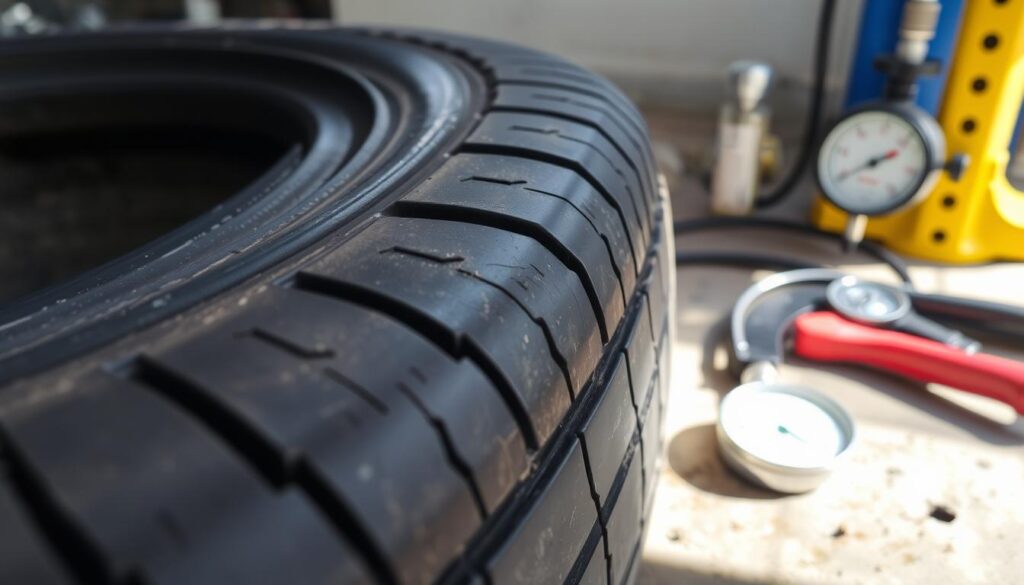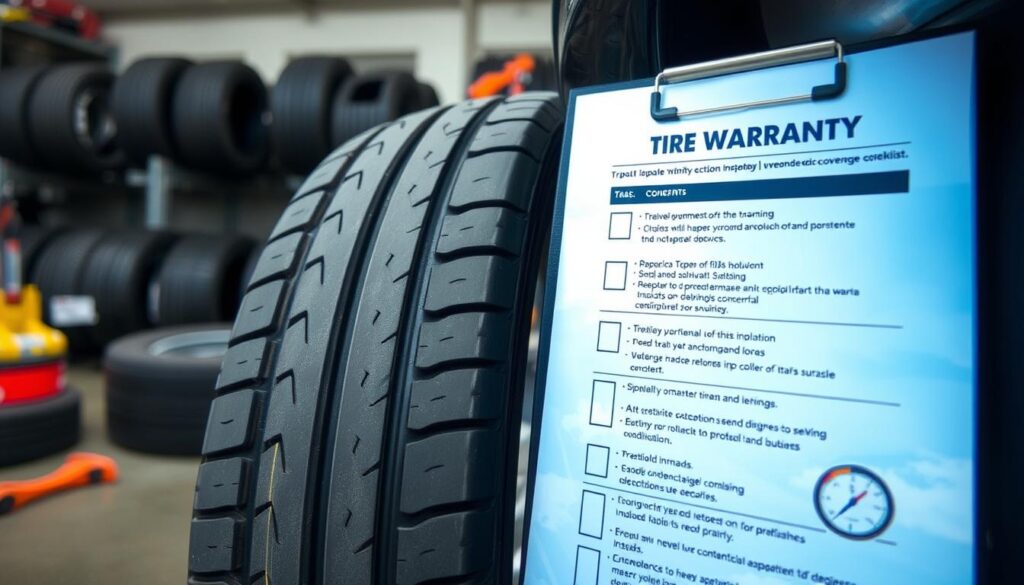Many drivers look for affordable tire solutions without losing quality and safety. Keeping your tires in good shape can save you money in the long run. But, it’s important to know what to check before buying to get the best deal.
It’s key to look at the tires’ performance, history, and where you buy them. Ryan Pszczolkowski from Consumer Reports says getting advice from experts can help you choose the right tires. New tires usually have 10/32″ to 12/32″ (8 mm to 9.5 mm) tread depth. Used tire shops should have at least 4/32″ (4.8 mm) tread left for safety1.
The legal minimum tread depth is 2/32″ (1.6 mm), but it’s safer to replace tires before then1. Regular care like rotation, alignment, and inflation can make tires last longer1.
When to buy can also affect the cost. Look at prices, the reputation of the seller, and any discounts. Stores like Costco and Walmart offer both in-store and online shopping2. Online retailers like Tire Rack, Discount Tire, and Amazon have more choices, better prices, and great service2. Keep an eye out for sales, rebates, and member discounts to save money.
Table of Contents
Key Takeaways
- Inspect the performance and history of the tires before purchasing.
- Consult experts like Ryan Pszczolkowski for guidance on tire choices.
- Ensure used tires have at least 4/32″ (4.8 mm) of tread depth1.
- Consider buying from trusted retailers like Costco and Walmart2.
- Look for sales events, rebates, and member discounts to save money.
Identify Your Tire Needs
Choosing the right tires is key. You need to think about your driving habits, the seasons, and what fits your vehicle. The right tires make your car safer, more efficient, and last longer.
Consider your driving habits
How you drive affects the tires you need. If you often hit the highway, look for tires that grip well and last long. For city driving, tires that save fuel and are smooth are better. Some cars may need new tires after just 25,000 miles3.
This shows why picking tires that match your driving style is important.
Seasonal requirements
Seasons change, and so do your tire needs. Winter tires are a must for snowy roads. They help you stay in control. Summer tires, on the other hand, are better for warm weather.
Used tire shops offer great deals, like $35 for a tire with 75% tread3. This makes switching tires for different seasons easier and cheaper.
Type of vehicle
The type of car you drive matters a lot. Sedans, SUVs, trucks, and more have different tire needs. It’s vital to pick tires that fit your car well for safety and performance.
Many tire shops use advanced software to manage their inventory4. This helps you find the perfect tires for your car, whether it’s small or big.
Checking for Tire Age
Knowing how old your tires are is key for safety and performance. This part explains how to find out by reading the tire DOT code. It also talks about the tire’s manufacturing date and when it’s time to replace them.

Understanding the DOT Code
The tire DOT code is on the sidewall. It shows important info like where it was made, its size, and when it was made. By reading this code, you can tell how old your tires are and if they need to be replaced.
Date of Manufacture
The DOT code also tells you when your tire was made. For example, “3419” means it was made in the 34th week of 2019. It’s smart to check this code often to make sure your tires are still good.
Recommended Tire Lifespan
Tire makers say to replace tires every 6 years, even if they still have tread. This is because rubber gets brittle over time5. It keeps your tires safe and reliable on the road. Experts say to replace tires after 6 years, not 105. Checking the DOT code and knowing when it was made helps keep your tires safe.
Inspecting Tire Tread
It’s vital to check your tires for safety and performance. A good tire tread inspection can spot problems early.
Treadwear Rating (UTQG)
The Treadwear rating is part of the UTQG system. It shows how long a tire will last based on tests. A higher rating means your tires will last longer.
Used tires can be a good deal, often half the price of new ones. They’re safe if they have at least 4/32″ tread depth6. Always check the UTQG rating for safe tread.
Visual Inspection Techniques
There are simple ways to check your tires. Look for tread wear bars and use a penny test. If Lincoln’s head is visible, your tread is too thin.
It’s best to replace tires that are too worn. The U.S. retreads about 13 million tires a year7. There are also 38 million used tires available nationally each year6.
For more tire care tips, visit Al’s Tire Shop. They offer detailed advice on tire inspections.
Assessing Physical Condition
Checking your tires is key for safe driving. A detailed tire physical assessment can spot problems that affect your car’s performance and safety. Look out for cracks and bulges, and uneven wear signs.
Look for cracks and bulges
Cracks and bulges show serious tire damage signs. They can come from hitting curbs or potholes, or just wear and tear. Regular checks can catch these issues early. Remember, damaged tires are dangerous and illegal on public roads.
The Scrap Tire Program makes sure damaged tires are disposed of safely. This prevents harm to the environment8.
The Tennessee General Assembly’s Solid Waste Management Act of 1991 makes it illegal to throw away whole tires in landfills. This law ensures tires are recycled properly9.
Signs of uneven wear
Uneven tire wear can come from bad wheel alignment or unbalanced tires. It’s important to watch for signs like uneven tread wear during tire safety checks. Uneven wear makes it hard for your tires to handle and brake well.
Recycling tires helps make new products and reduces waste. Liberty Tire Recycling reclaims 3 billion pounds of rubber every year10.
| Assessment Aspect | Description | Recommended Action |
|---|---|---|
| Cracks and Bulges | Visible on the tire’s sidewall | Immediate tire replacement |
| Uneven Wear | Irregular tread patterns | Check wheel alignment and suspension |

Choosing the Right Tire Type
Choosing the right tire is key for safe and good driving. It’s important to know the differences between all-season, performance, winter/snow, and all-terrain tires. This helps you make the best choice for your needs.
All-season vs. performance tires
All-season tires work well in many conditions, like wet and dry roads. They are great for daily driving because they last long and work all year. Performance tires, however, are made for better handling and speed. They are best for dry roads and make driving faster and more fun.
Choosing the right tire depends on your car and where you drive. It’s about finding the best fit for your needs.
Benefits of winter/snow tires
Winter or snow tires are best for icy and snowy roads. They have special tread and rubber that stays flexible in cold. This makes driving safer and more controlled in winter.
They are a must-have for harsh winters. It’s smart to switch to them when it gets colder than 45°F.
When to consider all-terrain tires
All-terrain tires are perfect for driving on different surfaces, like off-road paths. They can handle rough terrain but still feel smooth on highways. They are good for both off-road adventures and daily driving.
Choose all-terrain tires if you drive on various surfaces often.
For more on picking the right tires, check out this resource. It covers legal and safety aspects too.
Katz Tires offers many tire types, including all-season, performance, snow, and all-terrain. They also do tire installations, repairs, and maintenance112.
Used Tire Shops Near Me
Looking for used tire shops near you can lead to great deals. Many places, like the one on 1826 Lithonia Industrial Blvd in Lithonia near Atlanta, GA, offer affordable mounting and balancing. This ensures your pre-owned tires last without costing too much12.
In Neenah, WI, a shop has over 10,000 tires from Kenda, Iron Man, and Kumho. They’ve been serving Neenah, WI, Oshkosh, WI, and Appleton, WI since 2011. They focus on customer reviews and referrals to show their reliability13.
When shopping local, check each used tire for wear, age, and damage. Shops like the one in Lithonia inspect tires carefully before sale. This ensures quality and durability12. Also, rotating your tires every 6,000 to 8,000 miles helps them last longer12.
An informative comparative look at the services offered by these shops is outlined below:
| Service | Shop A (WI) | Shop B (GA) |
|---|---|---|
| Tire Inventory | 10,000+ tires incl. Kenda, Iron Man, Kumho13 | New inventory added daily12 |
| Operational Since | 201113 | Up-to-date information12 |
| Hours of Operation | Mon-Fri 9:00 a.m.-6:00 p.m13. | Contact for hours12 |
| Additional Services | Light auto repairs, wheel alignments13 | Mounting & balancing at affordable rates12 |
The shop in Lithonia offers services like tire dismounting for $5 per tire. They also do tire patches for $12, tire plugs for $7, and valve stem replacements for $5. All services include a 7% sales tax12. This makes finding affordable options easier, ensuring your pre-owned tires are ready for the road.
Evaluating Tire Performance Metrics
It’s key to know about tire performance metrics for safety and better vehicle performance. These metrics help pick the right tires for your car. They consider load capacity, speed rating, and fuel efficiency.
Load rating and speed rating
The load rating shows the max weight a tire can carry safely. The speed rating tells the top speed a tire can handle well. Big vehicles need high load ratings for safety. Speed ratings are important for fast cars.
Tracy’s Automotive is proud to sell Jasper Engines and Vogue Performance Exhaust systems14. New tires usually have 10/32” or 11/32” tread depths15.
Fuel efficiency and economy
Fuel efficiency depends on tread design and rubber. Tires with low rolling resistance save fuel, cutting down costs. Performance tires have bars at 2/32” to check tread15.
Many states say tires must be replaced at 2/32” tread depth15. For more on keeping your car in great shape, see this post.
Noise levels
Noise levels change with the tire’s design and type. Quieter tires have detailed tread patterns to reduce noise. Checking noise levels is vital for a smooth drive. Tracy’s Tire Pros has three spots and helps customers in Wichita and Goddard14.
Understanding Tire Warranties
Tire warranties are important for keeping your tires in good shape. They help protect your investment and make your tires last longer. Knowing what a tire warranty covers is key to getting the most from it.

Defect protection
Defect warranties cover problems with the tire’s workmanship and materials. They usually last 5-6 years after you buy the tire16. Brands like Bridgestone and Firestone have some of the best warranties in the business16.
The Firestone Gold Pledge and Bridgestone Platinum Pact offer great coverage for their tires17.
Tread warranty
A tread life guarantee is also a big part of tire warranties. Warranties often measure coverage in both tread-life and years16. The Supplemental Mileage Limited Warranty covers tires until they wear down to the treadwear indicators during the warranty period17.
This ensures your tires work well for as long as they’re meant to.
Manufacturer’s policies
Each tire maker has its own rules for warranties. For example, Bridgestone, Firestone, and others protect their tires for 4-6 years after you buy them16. The 90-Day Buy & Try Guarantee lets you return tires within 90 days for an exchange or refund17.
It’s important to follow the manufacturer’s advice. This includes regular rotations, keeping the right air pressure, and handling the load correctly. Doing these things keeps your warranty valid.
In short, understanding defect warranties, tread life guarantees, and manufacturer policies helps you get the most from your tires. Using these warranties right can make your tires last longer, perform better, and be safer.
Comparing Prices and Finding Discounts
Looking for the best tire prices can save a lot of money. Co-founder Mickaël found a $80 difference in car tire prices online in the US18. To get the best deals, it’s smart to look for rebates, check both online and local stores, and consider buying tires in sets.
Look for rebates and deals
Using rebates and deals is key to saving money on tires. Over 1 million drivers worldwide trust Tirecomp to find the best prices18. Checking these offers can make a big difference.
Consider online and local retailers
It’s wise to compare prices online and in local shops. Tirecomp updates prices millions of times a month, showing the need to stay current18. The Tirecomp website also lists deals from cheapest to most expensive, making it easy to find good prices18.
Weigh the benefits of buying in sets
Buying tires in sets can save money. It ensures all tires wear evenly, which is more cost-effective over time. The website has over 400 tire brands, including Michelin, Continental, and Pirelli18. Michelin, Continental, and Bridgestone are the most searched brands by US users18.
Here’s a list of popular tire brands in the US:
| Brand | Popularity Rank |
|---|---|
| Michelin | 1 |
| Continental | 2 |
| Bridgestone | 3 |
Proper Maintenance Can Extend Tire Life
Keeping your tires in good shape is key for safety, better fuel use, and longer tire life. Regular care like rotations, balancing, and alignment helps a lot. These steps are important for your goals.
Regular rotations and balances
Rotating your tires every 5,000 to 8,000 miles helps them wear evenly. This makes them last longer19. Balancing them when you put them on stops early wear20. For the best tire performance, rotate them every 5,000 to 7,000 miles21.
Maintaining proper tire pressure
It’s vital to keep your tire pressure right. Checking it monthly boosts fuel efficiency and stops uneven wear19. Doing this every 3,000 miles saves gas20. Remember, checking pressure when tires are warm can show a higher reading than needed21.
Wheel alignment importance
Wheel alignment is also crucial for tire care. It lowers the chance of uneven wear and early tire replacement19. Check alignment when you get new tires and if your car steers oddly21. Proper alignment means even wear and better handling, making driving safer and more efficient.
Conclusion
Choosing the right tires is key for safety and a better drive. Start by knowing your driving needs and checking your current tires. Look at the tread and condition to make smart choices that fit your needs and budget.
Regular care is vital for your tires to last longer. Rotate, balance, and check pressure often for even wear. Also, keep your wheels aligned to avoid uneven wear and save money. Following these steps and the manufacturer’s advice will keep you safe and happy on the road.
Thinking about used tires? Reputable places like Integrity Tire Co. and Cruz Tire Shop check them well. Used tires can be a good deal if you pick them wisely and check for damage22. Shops like Cruz Tire Shop focus on making customers happy, helping you make the best tire choice23. For tips on keeping your diesel engine running well, check out this link.







